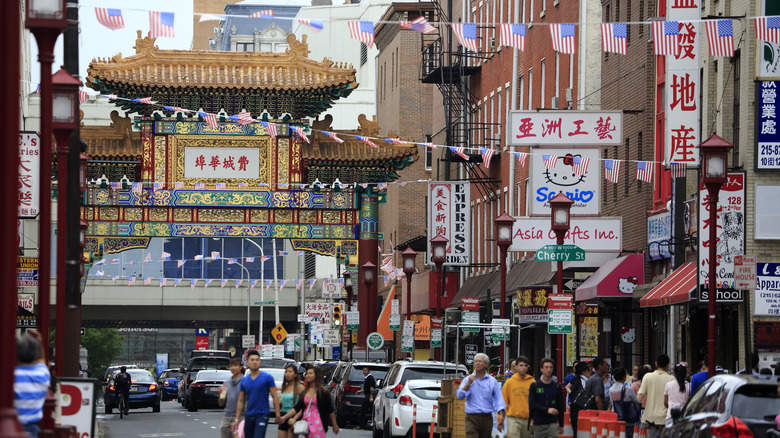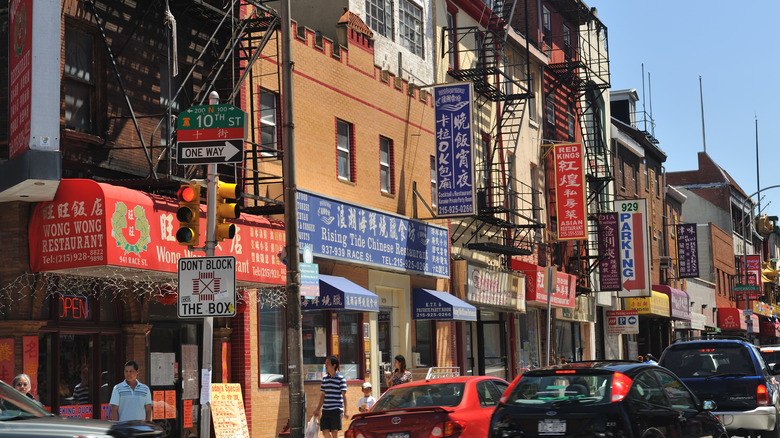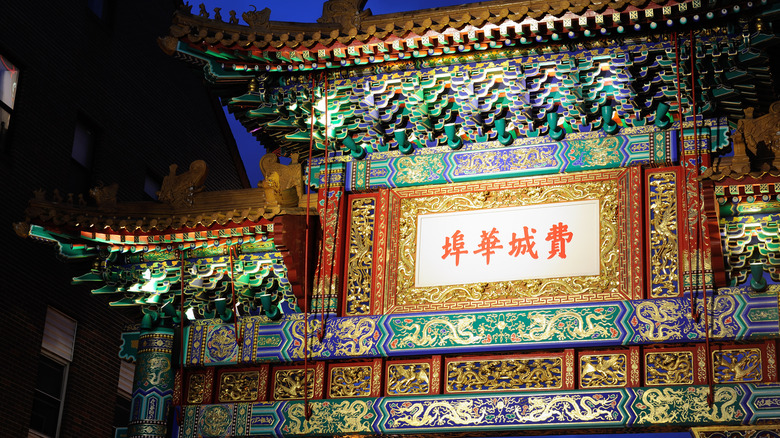One Of The America's Top Endangered Historical Sites Is A Must-Visit In Philadelphia
For the last 36 years, the National Trust for Historic Preservation has released a list of the country's "most endangered historic places," highlighting sites all across the U.S. that are in danger of disappearing. In 2023, the National Trust named 11 sites to its annual list, and many of them are bonded through a common historical theme of cultural diversity, remarkable social complexity, and an increasing danger of being erased from cityscapes. Among the list include important cultural community districts, like Little Santo Domingo in Miami, Florida, and Charleston's Historic Neighborhoods, as well as one of the oldest, and most culturally significant Chinatowns in the country, in one of the most underrated cities in America. Philadelphia's Chinatown neighborhood, a community for Asian immigrants since 1871, is significant as both an epicenter for diasporic history as well as home to streets full of historic 19th- and early 20th-century buildings. The district is home to more than 40 designated local landmarks that are culturally and historically significant to Philadelphia at large. But this enclave of culture is threatened with extinction via modern development.
As diasporic communities face challenges across the country, Philly's Chinatown unfortunately is a part of that story and is at risk of erasure, fighting large-scale development and displacement of populations, particularly the elderly. More than 25% of the original Chinatown district has been conceded to modern development, and in 2022 the city's professional basketball team, the 76ers, announced their intention to build their arena right on the district's border. The local community is worried that residents of the area are not a part of the planning process, and that such gentrification can negatively impact locally-owned businesses, increase traffic and congestion, and push the cost of living to the point where many members of the Asian or immigrant community who have lived in the area for decades can no longer afford to stay. With that said, visitors to Philadelphia have a role to play in Chinatown's preservation, so don't miss out on this vibrant and dynamic community when you visit the City of Brotherly Love.
Why Philadelphia's Chinatown is culturally important
Philadelphia's Chinatown is incredibly important to the nation for a number of reasons. One of the oldest examples of Chinatowns in the country, the community is a natural exhibition of the history and narrative of Asian and Chinese immigration into the U.S. in the 19th century, and into the 20th and 21st centuries. As the National Trust describes, Philadelphia's Chinatown is significant, not just for its building history, but also for its role in the preservation of traditions and customs for the local population. Both the physical record of the community via its buildings, as well as its place for those customs to thrive, are at risk of erasure.
But all of this doesn't mean that Chinatown is stuck in the past or is against progress in any way. Today, the area is a haven for cultural traditions and celebrations from many diasporic populations that seek to keep their culture alive, while simultaneously inviting other Philadelphians to experience the community with them. The Chinatown Friendship Gate, one of the most iconic sites within Chinatown, is a testament to that. Originally designed in 1984 with a restoration in 2008, the Friendship Gate embodies the spirit of Chinatown's population. Designed with historic and cultural cues from the Qing Dynasty and paying homage to Philly's sister city, Tianjin, the gate is a reminder of the colorful community that was built within the district.
And of course, no discussion about Chinatown would be complete without mention of its important culinary culture. Philadelphia's Chinatown has been acknowledged and rewarded by international culinary bodies but also serves as the heartbeat of local communities bonded through food. Chinatown is a space where these cultural connections, through food or otherwise, can take place, and losing a place like it could mean losing a cultural crossroads.
What can we do as travelers to support this endangered spot?
Chinatown stretches across 20 city blocks in the very walkable central part of Philadelphia, so its reach, both geographically and historically, is quite large, welcoming visitors today to experience their locally owned shops and restaurants and to attend cultural ceremonies and events. And really, visiting Philly's Chinatown to shop and eat local is one of the best ways to preserve and advocate for the district as a cultural hub. Be sure to stop by the area's many amazing restaurants as an introduction to the community. On a cold day, don't skip Chuan Kee Skewer for a unique Northern-Chinese-style hot pot, and if you're craving dim sum, then head to Ocean Harbor for an authentic experience. To try food from one of the other diasporic communities that have called Chinatown home in recent decades, head to Dae Bak for classic Korean comfort food. If you want to immerse yourself in one of those cultural practices that are inadvertently preserved in Chinatown, stop by the Asianfresh Food Market. The experience will transport you to a classic night market like you'd see in Asia.
If a visit to Chinatown inspires you to get more involved in its preservation, consider participating in local efforts with organizations like the Philadelphia Chinatown Development Corporation, whose mission is to advocate for the community in economic and cultural matters. Or, if you're curious about other sites that the National Trust has named as endangered, consider looking at a site in your home area to help preserve as well. And of course, when you travel, shop and eat local to boost the communities that you're visiting. And who knows, perhaps this adventure into Philadelphia's Chinatown will inspire you to visit others across the country, like the famous San Francisco Chinatown or Chicago's Chinatown, one of the best in America. Whatever travel and preservation/advocacy looks to you, remember, you can help to save some of these endangered sites, just by engaging.


